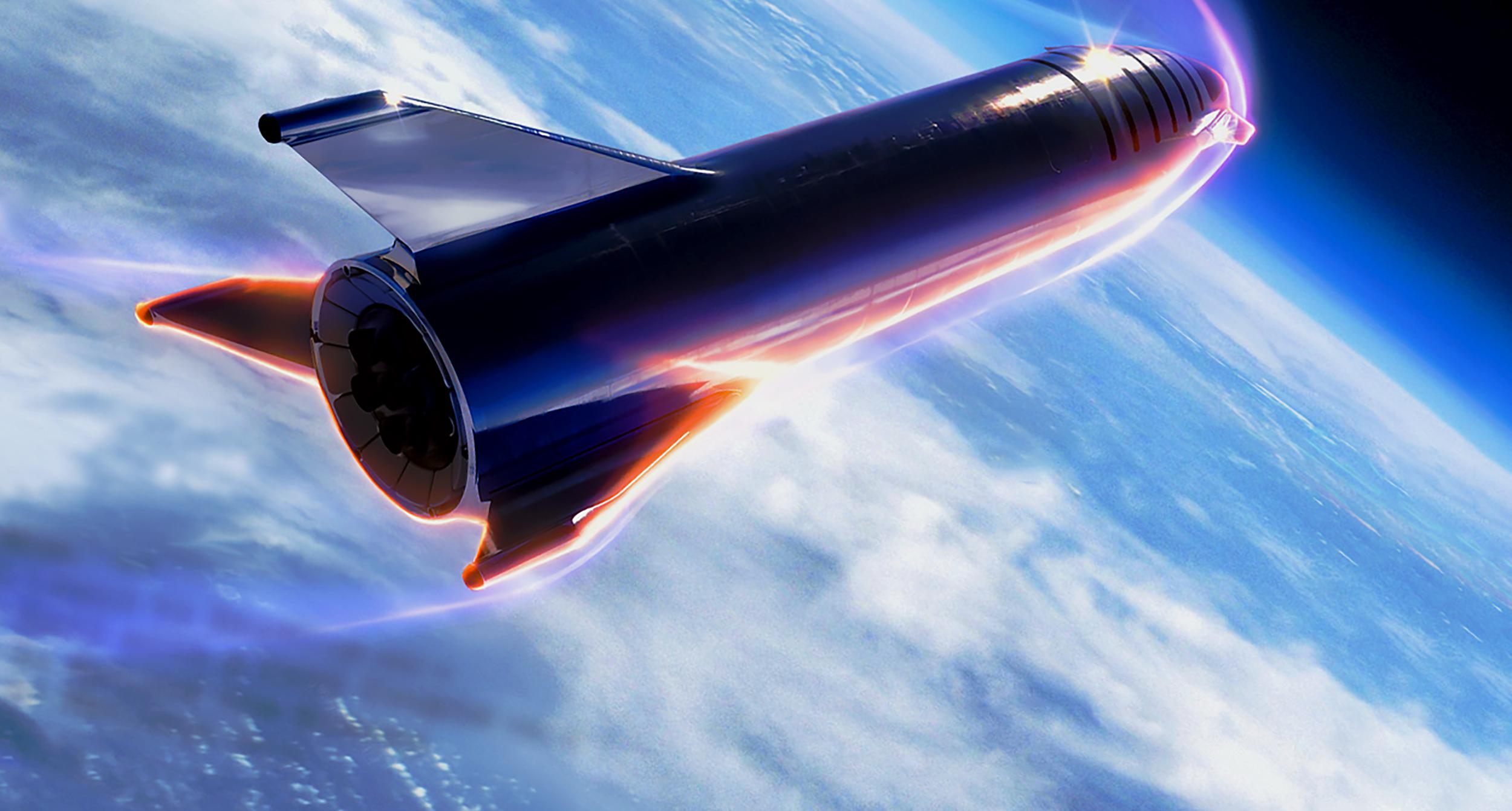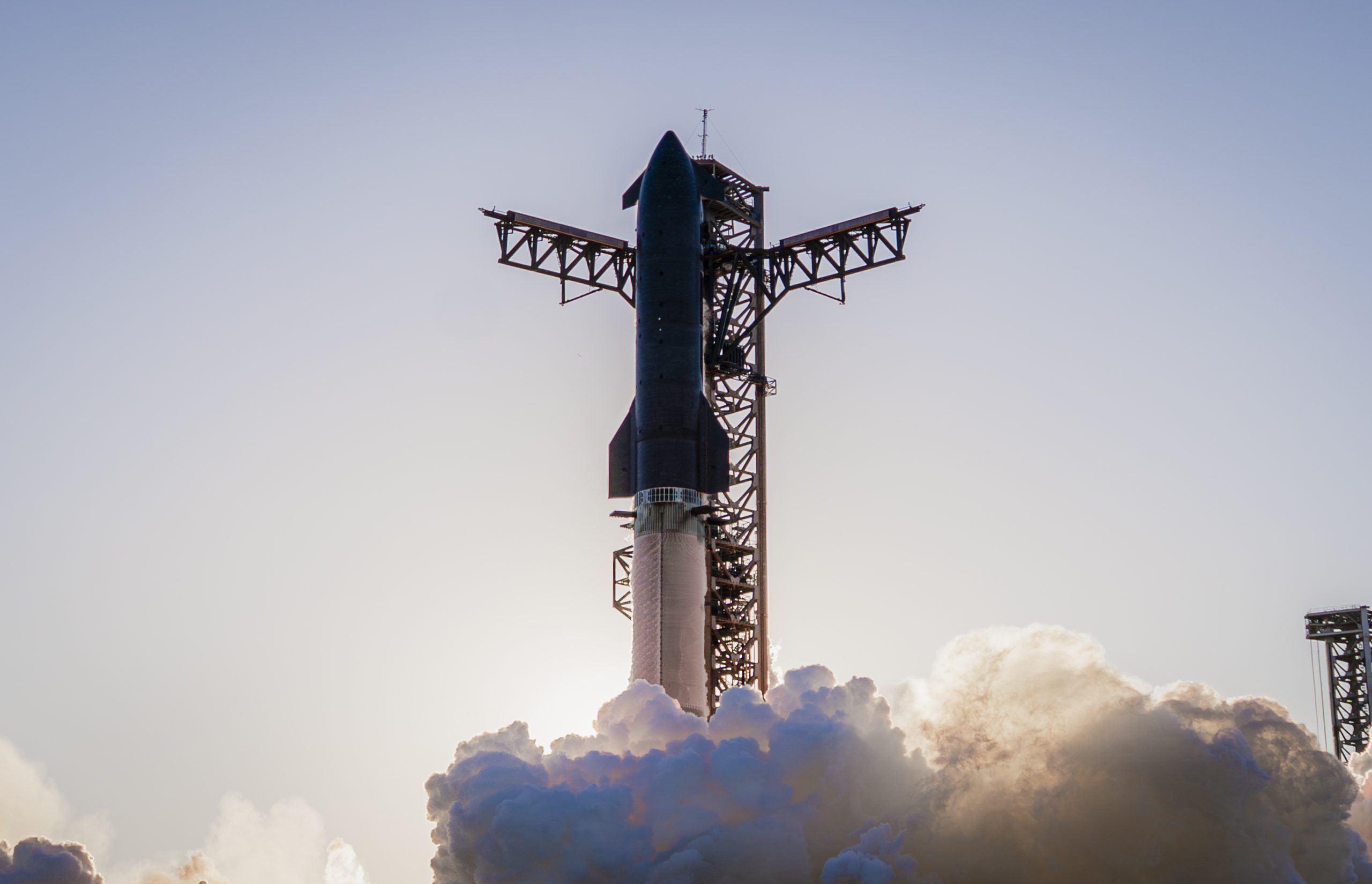

SpaceX
SpaceX’s steel Starship glows during Earth reentry in first high-quality render
SpaceX has silently published the first known detailed render of its new stainless steel Starship’s design on the cover of Popular Mechanic’s April 2019 issue, showing the next-generation orbital spacecraft reentering Earth’s atmosphere in a blaze of glowing metal and plasma.
Despite the fact that the render seems to only be available in print and then only through one particular news outlet, Teslarati has acquired a partial-resolution copy of the image to share the latest official glimpse of SpaceX’s Starship with those who lack the means, access, or interest to purchase a magazine. Matters of accessibility aside, SpaceX’s updated render offers a spectacular view of Starship’s exotic metallic heat shield in action, superheating the atmosphere around it to form a veil of plasma around the spacecraft’s hull. According to CEO Elon Musk, the hottest parts of Starship’s skin will be reinforced with hexagonal tiles of steel and transpiration cooling, a largely unproven technology that SpaceX is already in the process of testing.
Aside from one additional view – again only distributed to Popular Mechanic – showing a far wider angle of a SpaceX Starship entering the Martian atmosphere and video shown by CEO Elon Musk to students in Flint, MI a few days ago, this appears to be the first official render of an unequivocally metallic Starship. Aside from its shiny steel exterior, this latest render also offers an exceptionally-illustrated artist’s interpretation of what a Starship with metallic thermal protection might look like during reentry, appearing to take into account a number of things that set such a system apart from traditional heat shielding.

Aside from NASA’s Space Shuttle, which used fragile tiles of insulating material in its reusable heat shield, no other spacecraft have been flown with a primary heat shields that experiences little to no ablation, meaning that the material itself is not eroded during peak heating. Ablative heat shields like the PICA-X system used on SpaceX’s Crew and Cargo Dragons produce distinctly different ‘tails’ during reentry, mainly as a result of the addition of ablated material, much like injecting different elements into a fire or using different materials in rocket nozzles can drastically change the color (and sometimes behavior) of the flame.
While the extreme compressive heating of spacecraft reentering Earth’s atmosphere at many miles/kilometers per second produces plasma instead of what humans recognize as fire, the general idea remains the same. Comparing the reentry tails of spacecraft like the Apollo Command Module, the Space Shuttle, and Orion makes it clear that each vehicle and heat shield produces a subtle but distinctly unique plasma tail over the course of several minutes of peak reentry heating, when the vehicle’s velocity is fast enough to compress atmospheric gases into plasma. Different ablators end up injecting different gases into the superheated plasma tail, hence the different appearance of each tail.
Transpiration cooling will be added wherever we see erosion of the shield. Starship needs to be ready to fly again immediately after landing. Zero refurbishment.— Elon Musk (@elonmusk) March 17, 2019
Aside from a unique lack of ablation for Starship’s stainless steel hull and curious hexagonal steel heat shield tiles, SpaceX may end up having to implement a wholly unproven technology known as transpiration cooling, in which some of
It’s unclear what the resulting methane-rich plasma plume might look like but it’s not out of the question that SpaceX’s graphic design team have either done the math themselves, so to speak, or asked engineers to verify what color Starship’s plasma tail might end up looking like. As shown in the latest render, a plume of hues ranging from light blue and indigo to red through white seems entirely plausible. Regardless, Starship is bound to look spectacular during orbital reentries thanks to its metallic skin and shield and planned hot structure, meaning that the entire windward half of the vehicle could end up glowing red, orange, yellow, and even white-hot, precisely like the thermal testing video Musk recently shared.
SpaceX’s first orbital Starship prototype is already under construction at the company’s ad-hoc South Texas ‘shipyard’, for lack of a better term. According to Musk, that vehicle could be ready to be done “around June” of this year, while its complimentary Super Heavy booster could begin assembly as early as April thru June, as well.
Check out Teslarati’s Marketplace! We offer Tesla accessories, including for the Tesla Cybertruck and Tesla Model 3.

Elon Musk
SpaceX maintains unbelievable Starship target despite Booster 18 incident
It appears that it will take more than an anomaly to stop SpaceX’s march towards Starship V3’s refinement.

SpaceX recently shared an incredibly ambitious and bold update about Starship V3’s 12th test flight.
Despite the anomaly that damaged Booster 18, SpaceX maintained that it was still following its plans for the upgraded spacecraft and booster for the coming months. Needless to say, it appears that it will take more than an anomaly to stop SpaceX’s march towards Starship V3’s refinement.
Starship V3 is still on a rapid development path
SpaceX’s update was posted through the private space company’s official account on social media platform X. As per the company, “the Starbase team plans to have the next Super Heavy booster stacked in December, which puts it on pace with the test schedule planned for the first Starship V3 vehicle and associated ground systems.”
SpaceX then announced that Starship V3’s maiden flight is still expected to happen early next year. “Starship’s twelfth flight test remains targeted for the first quarter of 2026,” the company wrote in its post on X.
Elon Musk mentioned a similar timeline on X earlier this year. In the lead up to Starshp Flight 11, which proved flawless, Musk stated that “Starship V3 is a massive upgrade from the current V2 and should be through production and testing by end of year, with heavy flight activity next year.” Musk has also mentioned that Starship V3 should be good enough to use for initial Mars missions.
Booster 18 failure not slowing Starship V3’s schedule
SpaceX’s bold update came after Booster 18 experienced a major anomaly during gas system pressure testing at SpaceX’s Massey facility in Starbase, Texas. SpaceX confirmed in a post on X that no propellant was loaded, no engines were installed, and personnel were positioned at a safe distance when the booster’s lower section crumpled, resulting in no injuries.
Still, livestream footage showed significant damage around the liquid oxygen tank area of Booster 18, leading observers to speculate that the booster was a total loss. Booster 18 was among the earliest vehicles in the Starship V3 series, making the failure notable. Despite the setback, Starship V3’s development plans appear unchanged, with SpaceX pushing ahead of its Q1 2026 test flight target.
Elon Musk
SpaceX issues statement on Starship V3 Booster 18 anomaly
The incident unfolded during gas-system pressure testing at the company’s Massey facility in Starbase, Texas.

SpaceX has issued an initial statement about Starship Booster 18’s anomaly early Friday. The incident unfolded during gas-system pressure testing at the company’s Massey facility in Starbase, Texas.
SpaceX’s initial comment
As per SpaceX in a post on its official account on social media platform X, Booster 18 was undergoing gas system pressure tests when the anomaly happened. Despite the nature of the incident, the company emphasized that no propellant was loaded, no engines were installed, and personnel were kept at a safe distance from the booster, resulting in zero injuries.
“Booster 18 suffered an anomaly during gas system pressure testing that we were conducting in advance of structural proof testing. No propellant was on the vehicle, and engines were not yet installed. The teams need time to investigate before we are confident of the cause. No one was injured as we maintain a safe distance for personnel during this type of testing. The site remains clear and we are working plans to safely reenter the site,” SpaceX wrote in its post on X.
Incident and aftermath
Livestream footage from LabPadre showed Booster 18’s lower half crumpling around the liquid oxygen tank area at approximately 4:04 a.m. CT. Subsequent images posted by on-site observers revealed extensive deformation across the booster’s lower structure. Needless to say, spaceflight observers have noted that Booster 18 would likely be a complete loss due to its anomaly.
Booster 18 had rolled out only a day earlier and was one of the first vehicles in the Starship V3 program. The V3 series incorporates structural reinforcements and reliability upgrades intended to prepare Starship for rapid-reuse testing and eventual tower-catch operations. Elon Musk has been optimistic about Starship V3, previously noting on X that the spacecraft might be able to complete initial missions to Mars.
Elon Musk
SpaceX Starship Version 3 booster crumples in early testing
Photos of the incident’s aftermath suggest that Booster 18 will likely be retired.

SpaceX’s new Starship first-stage booster, Booster 18, suffered major damage early Friday during its first round of testing in Starbase, Texas, just one day after rolling out of the factory.
Based on videos of the incident, the lower section of the rocket booster appeared to crumple during a pressurization test. Photos of the incident’s aftermath suggest that Booster 18 will likely be retired.
Booster test failure
SpaceX began structural and propellant-system verification tests on Booster 18 Thursday night at the Massey’s Test Site, only a few miles from Starbase’s production facilities, as noted in an Ars Technica report. At 4:04 a.m. CT on Friday, a livestream from LabPadre Space captured the booster’s lower half experiencing a sudden destructive event around its liquid oxygen tank section. Post-incident images, shared on X by @StarshipGazer, showed notable deformation in the booster’s lower structure.
Neither SpaceX nor Elon Musk had commented as of Friday morning, but the vehicle’s condition suggests it is likely a complete loss. This is quite unfortunate, as Booster 18 is already part of the Starship V3 program, which includes design fixes and upgrades intended to improve reliability. While SpaceX maintains a rather rapid Starship production line in Starbase, Booster 18 was generally expected to validate the improvements implemented in the V3 program.
Tight deadlines
SpaceX needs Starship boosters and upper stages to begin demonstrating rapid reuse, tower catches, and early operational Starlink missions over the next two years. More critically, NASA’s Artemis program depends on an on-orbit refueling test in the second half of 2026, a requirement for the vehicle’s expected crewed lunar landing around 2028.
While SpaceX is known for diagnosing failures quickly and returning to testing at unmatched speed, losing the newest-generation booster at the very start of its campaign highlights the immense challenge involved in scaling Starship into a reliable, high-cadence launch system. SpaceX, however, is known for getting things done quickly, so it would not be a surprise if the company manages to figure out what happened to Booster 18 in the near future.










